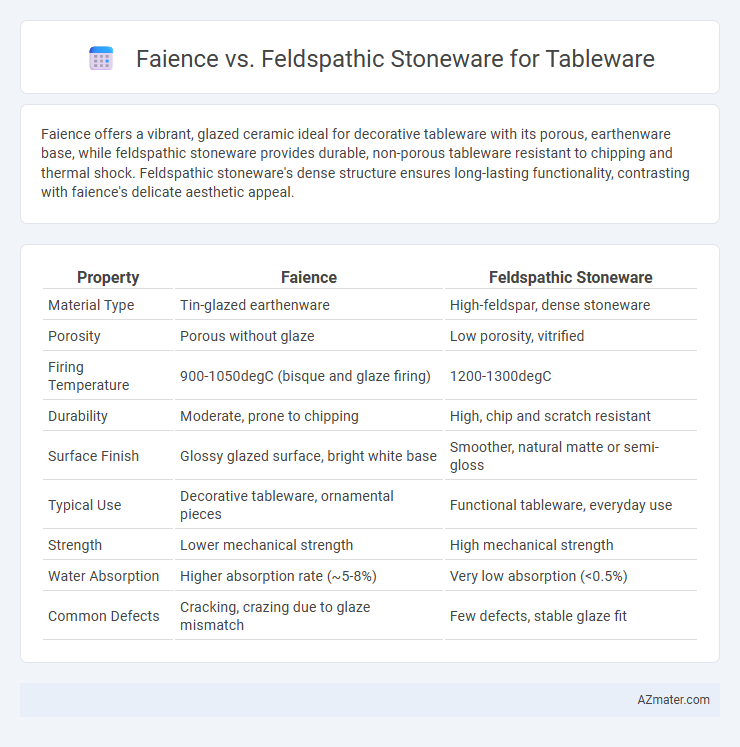Faience offers a vibrant, glazed ceramic ideal for decorative tableware with its porous, earthenware base, while feldspathic stoneware provides durable, non-porous tableware resistant to chipping and thermal shock. Feldspathic stoneware's dense structure ensures long-lasting functionality, contrasting with faience's delicate aesthetic appeal.
Table of Comparison
| Property | Faience | Feldspathic Stoneware |
|---|---|---|
| Material Type | Tin-glazed earthenware | High-feldspar, dense stoneware |
| Porosity | Porous without glaze | Low porosity, vitrified |
| Firing Temperature | 900-1050degC (bisque and glaze firing) | 1200-1300degC |
| Durability | Moderate, prone to chipping | High, chip and scratch resistant |
| Surface Finish | Glossy glazed surface, bright white base | Smoother, natural matte or semi-gloss |
| Typical Use | Decorative tableware, ornamental pieces | Functional tableware, everyday use |
| Strength | Lower mechanical strength | High mechanical strength |
| Water Absorption | Higher absorption rate (~5-8%) | Very low absorption (<0.5%) |
| Common Defects | Cracking, crazing due to glaze mismatch | Few defects, stable glaze fit |
Introduction to Faience and Feldspathic Stoneware
Faience is a tin-glazed earthenware known for its bright white, opaque surface and vibrant painted decoration, commonly used in traditional European tableware. Feldspathic stoneware contains a high percentage of feldspar, resulting in a dense, durable, and vitrified ceramic body ideal for functional, everyday tableware. The key difference lies in faience's porous, glazed surface versus feldspathic stoneware's hard, non-porous, and chip-resistant properties.
Historical Background of Both Materials
Faience, a tin-glazed earthenware originating in the Renaissance period, gained popularity for its bright, opaque surface ideal for colorful decoration and was widely produced in Europe, especially in Italy and France. Feldspathic stoneware, developed later during the 18th century, contains feldspar minerals that give it durability, translucency, and a slightly glassy texture, becoming prominent in English and German tableware production. Both materials reflect distinct historical advancements in ceramic technology, with faience known for its decorative appeal and feldspathic stoneware valued for its strength and refined aesthetics in everyday and formal dining contexts.
Composition and Manufacturing Processes
Faience is a tin-glazed earthenware composed mainly of clay with a coating of opaque white glaze, fired at lower temperatures around 900-1100degC, which allows vibrant enamel decoration. Feldspathic stoneware consists of a higher percentage of feldspar and is fired at higher temperatures between 1200-1300degC, resulting in a denser, vitrified body with greater mechanical strength and reduced porosity. The manufacturing process of faience emphasizes detailed surface glazing and decoration, while feldspathic stoneware focuses on durability and functional resistance due to its glassy matrix formed by feldspar flux.
Visual Differences: Appearance and Glaze
Faience tableware features a tin-glazed surface with a bright, opaque white background that allows for vibrant, intricate painted designs and a glossy finish, creating a decorative and colorful appearance. Feldspathic stoneware exhibits a denser, non-porous body with a natural, earthy tone and a typically clear or translucent glaze that enhances the stoneware's subtle texture and muted color palette. The visual contrast lies in faience's glossy, vividly decorated aesthetic versus feldspathic stoneware's understated, smooth, and naturally colored surface.
Durability and Strength Comparison
Faience, a tin-glazed earthenware, offers decorative appeal but has lower durability and is more prone to chipping compared to feldspathic stoneware, which boasts higher strength due to its vitrified, dense composition. Feldspathic stoneware's enhanced resistance to thermal shock and everyday wear makes it ideal for functional tableware exposed to frequent use. The dense, non-porous surface of feldspathic stoneware also provides superior stain resistance and longevity relative to the more porous faience.
Porosity and Water Resistance
Faience exhibits higher porosity compared to feldspathic stoneware, making it more susceptible to water absorption and less suitable for frequent use with liquids. Feldspathic stoneware has a dense, vitrified body that significantly reduces porosity and enhances water resistance, resulting in superior durability and hygiene for tableware. The low porosity of feldspathic stoneware prevents staining and bacterial growth, making it an ideal choice for practical, everyday dinnerware.
Suitability for Everyday Tableware Use
Faience offers a decorative appeal with its glazed surface but is more porous and less durable, making it less suitable for everyday tableware use. Feldspathic stoneware, composed of natural clay and feldspar, provides superior strength, chip resistance, and durability, ideal for frequent handling and dishwasher use. Its non-porous, vitrified surface ensures hygiene and longevity, making feldspathic stoneware the preferred choice for everyday tableware.
Maintenance and Care Guidelines
Faience tableware demands gentle handling due to its porous nature, requiring hand washing with mild detergents to prevent glaze damage and avoid thermal shock by not exposing it to sudden temperature changes. Feldspathic stoneware offers higher durability and is typically dishwasher safe, but it benefits from avoiding abrasive cleaners to maintain its glaze integrity. Both materials should be stored carefully to prevent chipping, with faience needing extra cushioning because of its relative fragility compared to the more robust feldspathic stoneware.
Cost and Accessibility in the Market
Faience tableware typically offers a lower price point compared to feldspathic stoneware due to its cheaper raw materials and less intensive manufacturing process, making it widely accessible for budget-conscious consumers. Feldspathic stoneware, known for its durability and vitrified body, commands a higher price and is often available through specialty retailers or upscale markets, limiting its accessibility. Market availability of faience is more extensive, found easily in department stores and online platforms, whereas feldspathic stoneware is predominantly sold in niche or artisanal outlets.
Sustainability and Environmental Impact
Faience tableware, made from glazed earthenware clay, generally requires lower firing temperatures than feldspathic stoneware, resulting in reduced energy consumption and a smaller carbon footprint during production. Feldspathic stoneware, known for its durability and resistance to thermal shock, often demands higher firing temperatures, increasing energy use and environmental impact. Choosing faience for tableware can promote sustainability through energy-efficient manufacturing, although feldspathic stoneware offers longer product lifespan, potentially reducing waste over time.

Infographic: Faience vs Feldspathic Stoneware for Tableware
 azmater.com
azmater.com